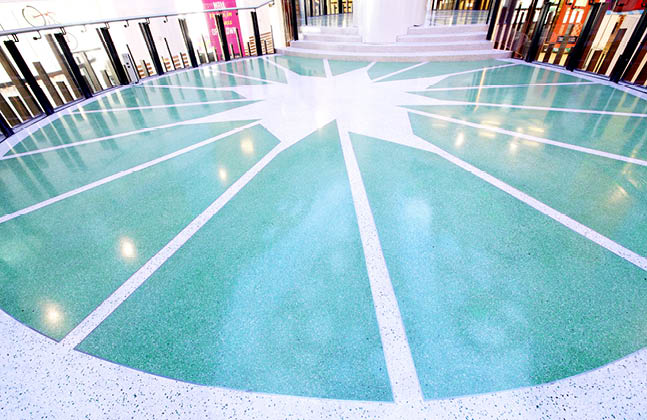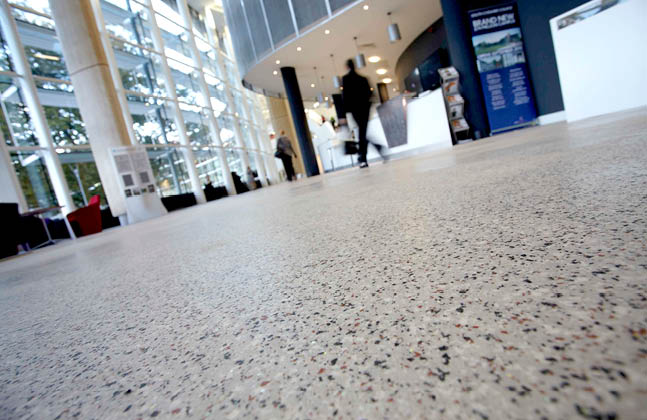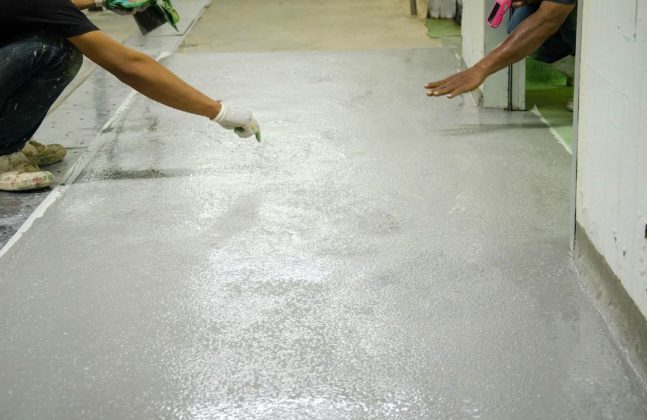When examining flooring options for industrial spaces, choosing a best-value option can be an arduous assignment. There is an array of options, each with their own ideal attributes for industrial markets. Determining which attributes are better suited for your operation will yield a more perfect fit.
Epoxy and polished concrete tend to be the best combination of effectiveness and value. Whether it’s aesthetics, durability, cost or maintenance requirements, each option has its benefits, and placing a personal importance on a few of them will help find which is the perfect flooring material for your industrial space.
Epoxy Flooring
Epoxy flooring is a thermosetting resin applied as a protective and decorative coating to a concrete substrate. Epoxy has many benefits to match a number of unique characteristics.
- Aesthetics – Epoxy flooring can be applied in a range of stains and customizable color options in addition to a variety of gloss levels. Further design options include the addition of colored microchips and metallic finishes.
- Maintenance – Since epoxy is a seamless flooring option, the substrate is protected from chemicals, dirt, liquids and other contaminants. This makes the floors easy to clean, requiring only a walk behind scrubber or standard mopping with a general-purpose cleaner – no waxing or buffing is necessary. Epoxy floors do not require much maintenance other than standard cleaning, making them a great long-term value option.
- Safety – One of the lesser-known advantages of epoxy flooring is its non-slip surface. This is an important facet for every commercial space as safety should always be a primary concern.
- Durability – Workloads on epoxy floors can vary from foot traffic to truck and forklift traffic. This industrial flooring option can withstand daily abuse from a wide variety of equipment and manufacturing processes. As an abrasion and chemical-resistant material, epoxy flooring meets the durability needs of most industrial manufacturers.
- Installation – Having a professional flooring contractor to oversee the installation is critical. Improper installation will cause the coating to prematurely chip and peel. Additionally, the substrate must be properly prepped before any coating can be applied. Installation time varies dependent on thickness and size of the project. A 10k square-foot installation can most often be completed in about one week.
- Costs – Cost considerations will vary depending on size, design and layout, but on average, prices vary between $4 and $8 per square-foot. Lifecycle costs are usually advantageous for epoxy floors as their low maintenance combined with longevity and durability lead to low costs post installation.
- Applications – As one of the most versatile flooring options, epoxy flooring is great for industrial, commercial, correctional, medical, food manufacturing, aviation, recreational, healthcare, transportation, manufacturing, veterinary, educational, grocery and retail markets.

Polished concrete flooring
A polished concrete system uses a concrete slab-on-grade as the finished floor surface. The concrete substrate is treated with a chemical densifier to increase hardness, polished with a series of diamond grit grinders and then treated with a sealant. There are many low-odor, nontoxic versions of densifiers and sealants, making polished concrete a sustainable flooring option, perfect for meeting green goals.
- Aesthetics – Installing a polished concrete floor opens a vast number of color and design options with a variety of gloss levels as well. Colors can be mixed and matched to create custom designs unique to your operation.
- Maintenance – Similar to epoxy floors, polished concrete is a low-maintenance option, requiring an occasional damp mopping. There is no need for additional coatings, reducing material and labor costs associated with maintenance for other floor systems.
- Durability – Polished concrete is very resistant to high foot traffic. Additionally, this flooring option can handle forklift traffic while resisting stains from oil or chemical spills.
- Installation – Timelines can vary depending on the size and intricacies of the design but a 5,000 square-foot to 15,000 square-foot installation typically takes a week or less. Other factors include the condition of the concrete slab, if it is new or old. The level of grinding, which goes into determining gloss and smoothness levels, may adjust the timeline.
- Costs – Using the substrate as the finished floor surface reduces material costs, making the installation process the bulk of the cost. On average, polished concrete costs will range between $3 and $6 per square foot. This is dependent on the size, the condition of the concrete substrate and the design details. Lifecycle costs are relatively low considering the low maintenance requirements and longevity of the flooring.
- Applications – Polished concrete flooring is very versatile as it’s a great option for industrial, warehouses, retail, hotels, restaurants, office buildings, hangars and auto service areas.

Either of these two flooring options would be great for an industrial space, but depending on which benefits you value more will determine which is the best-value option specifically for your needs. To learn more about finding the best long-term value, check out how to incorporate value engineering and life cycle costing into your flooring project.





